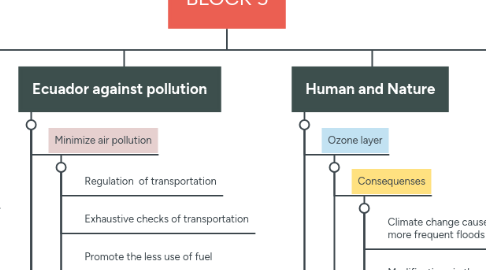
1. Human and Nature
1.1. Ozone layer
1.1.1. Consequenses
1.1.1.1. Climate change causes heat waves and more frequent floods and droughts.
1.1.1.2. Modifications in the ecosystems and the disappearance of beings alive.
1.1.1.3. Global warming is causing a rise in sea level by the thawing of ice from the polar ice caps.
1.1.1.4. The reduction of the ozone layer ultraviolet radiation increases.
1.1.2. Causes
1.1.2.1. The use of fossil fuels.
1.1.2.2. Forests are the lungs of the planet. They absorb carbon dioxide and produce oxygen.
1.1.2.3. The gases produced by some air conditioning systems, freezers and aerosols, such as those from lacquers and deodorants.
1.2. Garbage
1.2.1. Consequences
1.2.1.1. Excess waste pollutes the soil, water and air, and causes the death of many animal species and vegetables.
1.2.1.2. Threaten our health.
1.2.1.3. Landfills have an impact negative in the landscape and alter the ecosystems.
1.2.2. Causes
1.2.2.1. Excess of products.
1.2.2.2. Many products are throwaway.
1.2.2.3. Much of the waste we produce does not descompose.
1.3. Affencting layers
1.3.1. Atmosphere
1.3.1.1. Affect the air
1.3.2. Biosphere
1.3.2.1. Affect the flora and fauna
1.3.3. Geosphere
1.3.3.1. Affect the soil
1.3.4. Hydrosphere
1.3.4.1. Affect the water
2. POLLUTION
2.1. Concept
2.1.1. It´s caused by a pollultant that produce damage in an ecosystem, in the enviroment or in a linving beings.
2.2. Depend on how affect the enviroment
2.2.1. ATMOSPHERIC POLLUTION
2.2.1.1. Chemical substances in the atmosphere
2.2.1.1.1. smoke
2.2.1.1.2. gases
2.2.1.1.3. fluids
2.2.2. WATER POLLUTION
2.2.2.1. Waste in the water
2.2.3. SOIL POLLUTION
2.2.3.1. Waste on the land surface
2.3. Depend On the Pollutant
2.3.1. CHEMICAL POLLUTION
2.3.1.1. Chemicals from industrial action r
2.3.2. RADIOACTIVE POLLUTION
2.3.2.1. Materials from nuclear plants or radioactive waste
2.3.3. THERMAL POLLUTION
2.3.3.1. Caused by smoke, gases or fluids in the atmosphere.
2.3.3.1.1. Produce global warming
2.3.4. NOISE POLLUTION
2.3.4.1. Noise above natural levels
2.3.5. VISUAL POLLUTION
2.3.5.1. Comes from advertising
2.3.5.1.1. billboards
2.3.5.1.2. posters
2.3.5.1.3. landfills
2.3.6. LIGHT POLLUTION
2.3.6.1. Excess of artificial lighting
2.3.7. ELECTROMAGNETIC POLLUTION
2.3.7.1. Generated by electronic equipment
2.3.8. Microbiological
2.3.8.1. It is caused by sewage.
3. Measures against pollution
3.1. Sustaintable resources management
3.1.1. Adequate use of resources without over exploiting
3.1.2. Planification of needs
3.1.3. Responsible and efficient use of resources
3.2. Education
3.2.1. Waste reduction
3.2.2. Responsible use of measures
3.2.3. Educate of the consequences
3.3. Science and technology
3.3.1. Use of efficient machinery
3.3.1.1. Less fossil fuells
3.3.2. New techonology
3.3.2.1. Clean energy like solar and wind
3.3.3. Wastewater treatment systems
3.4. Ecological restoration
3.4.1. Reforestation with native species
3.4.2. Soil friendly agricultural practices
3.4.3. Elimination of invasive species
3.4.4. Reintroduction of native species
3.5. Create and care protected areas
3.5.1. Territories destinated for conservation of the biodiversity
3.5.2. In Ecuador there are 50 protected areas
3.5.3. Proximity to populated centers difficult taking care of protected areas
3.6. 3R'S
3.6.1. Reduce
3.6.1.1. Less garbage
3.6.2. Reuse
3.6.2.1. Materials
3.6.3. Recycle
3.6.3.1. Plastic, paper, glass, cardboard
4. Ecuador against pollution
4.1. Minimize air pollution
4.1.1. Regulation of transportation
4.1.2. Exhaustive checks of transportation
4.1.3. Promote the less use of fuel
4.1.4. Regulate the emission of gases in indutries and factories
4.2. Reforestation
4.2.1. Reduce the use of paper
4.2.2. Use recycle paper or materials
4.2.3. Use technology instead of paper
4.2.4. Promote recycling
4.3. Regulation of oil exploitation
4.3.1. Create laws to enviromentally friendly measures
4.3.2. Regulate the amount of oil for industries use
4.3.3. Improve wastewater treatment
4.3.4. Creacion of protected areas
4.4. Water care
4.4.1. Repair faulty installations that cause loss or leakage of water
4.4.2. Closed the faucet tightly
4.4.3. Do not leave the tap open
4.4.4. Open the shower when you will use
4.4.5. Use the washing machine with the full load of clothes
4.4.6. Regulate use of water in indutries and their wastewater treatment
4.4.7. Promote pollicies against use of innecessary water
4.5. Helping biodiversity
4.5.1. Prohibit the illegal hunting
4.5.2. Prevent forest fires
4.5.3. Promote measures to create protected areas and policies agaisnt deforestation
